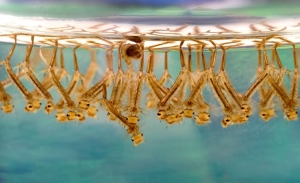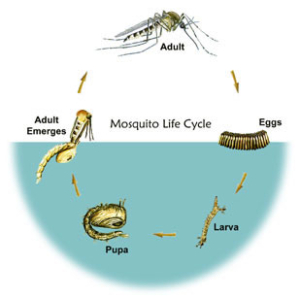**Mug-A-Bug Pest Control currently provides only governmental and large scale commercial mosquito control. Residential mosquito control is not available at this time as a majority of water breeding locations are not located on a single private residence. **
Approximately 40 species of mosquitoes are found in Colorado; however, roughly 3,500 species are known to exist worldwide. Mosquitoes develop though a series of four phases: egg, larva, pupa and adult. Adult females lay eggs in or near water. Those that are laid near a water source only hatch after water levels become high enough to cover the eggs. Once in water, eggs hatch relatively rapidly. Upon hatching, the larvae begin feeding on organic material and small aquatic organisms. Depending on the species, the larvae may stay at the surface or completely submerged while others will submerge and go to the surface periodically. Larvae are commonly known as “wrigglers” due to their wiggling movement. Controlling larvae prevents the occurrence of adults; therefore, the larval stage of development is most often targeted by mosquito management programs. The water source to be treated must be of adequate size to adhere to chemical control product labels. Residential homes rarely have a large enough breeding source of water to be professionally treated. Instead, homeowners are encouraged to remove standing water sources including old tires, tree holes, watering buckets and stagnant water sources such as ponds or water features that lack water circulation. Pupae, like larvae, only occur in water, typically at the surface. Mosquitoes do not feed during the pupae stage. This is the final stage before adults emerge.
Adult mosquitoes may remain within a short distance of the water source from which they developed or fly as far as ten miles from the initial source depending on their species. The most common distance averages 1-2 miles for feeding for adult mosquitoes. Adults can be found resting in vegetation or other protected areas when not searching for food. Males, which can be distinguished by their more prominent, feather looking antennae, feed only on nectar and pollen, whereas females also feed on blood meals from a variety of hosts. Females seek out blood meals during their breeding season as blood meals are necessary for the nutrition to produce eggs. Birds are a primarily sought out host for mosquitoes, which is unfortunately directly related to the spread of the West Nile Virus. Of the mosquito species in Colorado, the kind associated with the greatest spread of West Nile Virus are most active during July and August. Female mosquitoes are attracted to their hosts based on chemical cues (carbon dioxide, lactic acid, octenol, etc.), shape, color, heat and humidity. Individual people as well as animals produce differing cues, which may increase or decrease their attractiveness as a blood meal. Not all mosquito species feed on humans. When a female bites, she injects saliva that contains anticoagulants as well as other substances to insure continuous blood flow while she is feeding. A person’s reaction to a mosquito bite is a result of the proteins found in the saliva. As with insect stings, certain people have little to no reaction while others experience moderate to sever reactions to the bite of a mosquito.
Adult mosquitoes have a lifespan of a few weeks during the summer. In species that overwinter, their lifespan tends to be a few months. Mosquitoes transmit several important diseases and therefore precautions should be taken to deter mosquito activity and bites. In Colorado, the primary important mosquito borne diseases include not only West Nile Virus, but also western equine encephalitis, Saint Louis encephalitis and heartworm in both dogs and cats (this disease can occur in rare cases in humans as well). Non-biting midges are commonly mistaken for mosquitoes, especially during their mating swarms. These midges do not posses any health risks to humans. Another common group of insects that resemble a giant mosquito are crane flies. The sheer size of crane flies often startles people into thinking that they are capable of biting although the adults do not bite.

